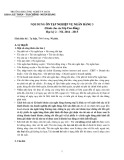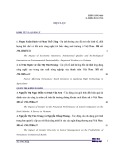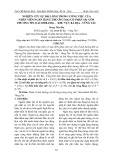
http://www.iaeme.com/IJM/index.asp 250 editor@iaeme.com
International Journal of Management (IJM)
Volume 7, Issue 7, November–December 2016, pp.250–256, Article ID: IJM_07_07_026
Available online at
http://www.iaeme.com/ijm/issues.asp?JType=IJM&VType=7&IType=7
Journal Impact Factor (2016): 8.1920 (Calculated by GISI) www.jifactor.com
ISSN Print: 0976-6502 and ISSN Online: 0976-6510
© IAEME Publication
PRODUCTIVITY ANALYSIS OF FOREIGN SECTOR
BANKS
Dr. P. K. Dhiman
Professor, Department of Management & Hum,
SLIET Longowal, Punjab, India
Rupani
Ph.D Research Scholar, Department of Management & Hum,
SLIET longowal, Punjab, India
ABSTRACT
In today’s era of globalization the customers are more and more demanding and their
expectations are changing with time in terms of various aspects like Quality, Quick & Effective
service. In this competitive environment it has become essential to retain existing and attract new
customers. For this purpose the banks should analyzed its productivity to make better policies. So
this study is confined to the measurement of productivity of Foreign sector banks. Information
Technology implementation has totally changed the way of Banking operations and revolutionized
the financial sector in India. So the measurement of the changes in the selected Five banks in terms
of Productivity on the basis of selected parameters is main focus. In the end the performance of Intra
sector banks in discussed in conclusion.
Key words: Productivity, PSBs’, Private sector banks, Information Technology (IT), Foreign
Sector Banks, Average, Standard Deviation (SD)
Cite this Article: Dr. P. K. Dhiman and Rupani, Productivity Analysis of Foreign Sector Banks.
International Journal of Management, 7(7), 2016, pp. 250–256.
http://www.iaeme.com/IJM/issues.asp?JType=IJM&VType=7&IType=7
1. INTRODUCTION
The measurement of Productivity is comprehensible indicator of the performance and growth. So the
measurement of productivity will provide the economic growth rate of Indian Banking Sector. The foreign
sector banks are also the great rivals to the Public sector banks and Private Sector Banks. The Public Sector
Banks are having the strong base and are well established by time but still they are lacking by Foreign sector
banks in some of the areas. So by the measurement of the productivity it will help to find out the exact picture
of foreign sector banks. The study based on parameters related to Employee, Branch and Financial etc. are
used to study the productivity. The total no. of parameters are seventeen. The Time period is taken after the
effective adoption of the computerization in Indian Banking industry.

Productivity Analysis of Foreign Sector Banks
http://www.iaeme.com/IJM/index.asp 251 editor@iaeme.com
2. OBJECTIVE OF THE STUDY
To analyse the productivity of the Intra-sector differentials of selected Foreign Sector Banks under study.
3. REVIEW OF LITERATURE
Khokhar (1999) said bank is assumed to produce investments and advances by employing purchased funds,
labour and physical capital as inputs. He studied and analyzed the required efficiency scores for 87
commercial banks operating in India during 1996-97 using stochastic frontier function, which is based on
cross section data concerning to one output namely productive assets consisting of investments and advances
and three inputs namely labour, deposits and borrowings, and physical capital. The efficiency scores vary
from 38 to 97% with the least and most efficient banks appearing to be foreign banks. Total assets and capital
adequacy ratio are the main descriptive factors for the efficiency variations. Moreover, ownership contributes
to the efficiency levels of foreign banks in India.
Singh, R (2003) in the study author made an attempt to analyze the profitability of banks with respect to
some performance parameters. Mr. Singh studied the all four major banking sector groups i.e. Public sector
banks (PSB), Private sector banks, New Private sector banks and foreign sector banks in the deregulated
environment. Author concluded that the competitiveness of all banks should be increased and the non interest
sources of income should be aken into consideration than other sources.
Uppal R. K. (2008) in this study Dr. Uppal analyzed the Quality of E- banking Services in the changing
environment. The adoption on Information Technology was the key feature of the changing environment,
which led to emergence of E-banking Services. The Impact of IT on various parameters of performance in
banks was also studied. In this Paper the Author Concluded that the Customers response to the e-banking
services is much more pleased with the different e-channels and their services in the spread of e-banking
services.
4. RESEARCH METHODOLOGY
The study is based on measurement of Productivity on the basis of some Parameters. By review of literature
seventeen (17) parameters have been selected to measure the productivity of Foriegn banks under study. All
the parameters have been shown in the table number 2. Statistical Methods like Mean, standard deviation
(SD) and F- Test is used to measure the significant variations.
5. SELECTION OF BANKS
The list of selected banks has been shown in the following the table number 1 and Five number of bank from
Foreign Sector Banks are randomly selected for the study. While selecting the banks the factor of market
share was also taken into consideration.
Table 1 list of Foreign Sector banks under study.
Bank Group Sr. No. Name of the Bank
Foreign Sector Banks
1 CITI Bank
2 Standard Charted Bank
3 HSBC Bank
4 DBS Bank
5 American Express Bank
6. INTRA SECTOR COMPARISON OF PRODUCTIVITY RATIOS IN
DIFFERENT FOREIGN SECTOR BANKS
Deposits per Employee: Information given in Table 3 showed the intra sector comparison of productivity
ratio in foreign sector banks. Average deposits per employee were highest of the order of Rs. 15.44 crore in
DBS Bank, followed by Rs. 9.80 crore in CITI Bank and Rs. 8.93 crore in Standard Charted Bank. Whereas

Dr. P. K. Dhiman and Rupani
http://www.iaeme.com/IJM/index.asp 252 editor@iaeme.com
the average deposits per employee was lowest of the order of Rs. 1.51 crore in American Express Bank
followed by Rs.6.88 crore in HSBC Bank. The analysis further showed that deposits per employee vary
significantly in all the foreign sector banks as shown by the F-ratio of 7.74.
Advances per Employee: Average advances per employee came to be Rs. 8.26 crore in CITI Bank, Rs. 8.80
crore in Standard Charted Bank, Rs. 4.10 crore in HSBC Bank, Rs. 11.20 crore in DBS Bank and Rs.1.78
crore in American Express Bank. The results showed that all the foreign sector banks under study vary
differently n advances per employee as revealed by the F-ratio of 5.27.
Business per Employee: Average business per employee was highest of the order of Rs. 26.65 crore in DBS
Bank, followed by Rs. 18.07crore in CITI Bank and Rs. 17.72 crore in Standard Charted Bank. The average
business per employee was lowest of the order of Rs. 3.28crore in American Express Bank followed by Rs.
10.98 crore in HSBC Bank. The analysis further revealed that business per employee differs significantly in
all the foreign sector banks as shown by the F-ratio of 10.33.
Total Expenditure per Employee: Average expenditure per employee came to be Rs. 1.30 crore in CITI
Bank, Rs. 0.81 crore in Standard Charted Bank, Rs. 0.73 crore in HSBC Bank, Rs. 2.20 crore in DBS Bank
and Rs. 0.63 crore in American Express Bank. The results showed that total expenditure per employee differ
significantly in all the foreign sector banks as shown by the f-ratio of 19.83.
Total Earning per Employee: Average earning per employee was highest of the order of Rs. 2.46 crore in
DBS Bank followed by Rs.1.59 crore in CITI Bank and Rs. 1.03 crore in Standard Charted Bank. Average
earning per employee was lowest of the order of Rs. 0.65 crore in American Express Bank and Rs. 0.88 crore
in HSBC Bank. F-ratio of 24.08 showed that total expenditure per employee differs significantly in all the
foreign sector banks under study.
Spread: Average spread in CITI Bank came to be 4.01 percent, 3.80 percent in Standard Charted Bank of
Baroda, 3.43 percent in HSBC Bank, 2.67 percent in DBS Bank and 1.95 percent in American Express Bank.
There was a significant difference in spread of all the foreign sector banks as revealed by the F-ratio of 16.27.
Establishment Expenses per Employees: Average establishment expenses per employee came to be
highest of the order of Rs. 0.50 crore in CITI Bank, followed by Rs. 0.44 crore in DBC Bank and Rs. 0.43
crore in American Express Bank. Average establishment expenses were lowest of the order of Rs. 0.28 crore
in HSBC Bank followed by Rs. 0.29 crore in Standard Charted Bank. The analysis showed that establishment
expenditure per employee differs significantly in all the foreign sector banks under study as shown by the F-
ratio of 4.02.
Deposits per Branch: Average deposits per branch came to be highest of the order of Rs. 1095.33 crore in
CITI Bank, followed by Rs. 858.34 crore in HSBC Bank and Rs. 853.29 crore in DBS Bank, while the
average deposits per branch were lowest of the order of Rs. 323.82crore in American express Bank, followed
by Rs. 794.77 crore in Standard Charted Bank. Significant F-ratio of 2.73 showed Deposits per branch were
significantly higher in CITI Bank as compared to other foreign sector banks under study.
Advances per Branch: Average advances per branch came to be highest of the order of Rs. 896.78 crore in
CITI Bank, followed by Rs. 728.90 crore in Standard Charted Bank and Rs. 601.25 crore in DBS Bank,
while the average deposits per branch were lowest of the order of Rs. 487.40 crore in American Express
Bank followed by Rs. 502.99 crore in HSBC Bank. There was no significant difference on the advances per
branch in all the Foreign Sector Banks as shown by the F-ratio of 1.47.

Productivity Analysis of Foreign Sector Banks
http://www.iaeme.com/IJM/index.asp 253 editor@iaeme.com
Table 3 Intra sector comparison of productivity ratios in Foreign sector Banks: 2000-2014
Ratio CITI Bank Standard
Charted Bank HSBC Bank DBS Bank American
Express Bank F-ratio
Mean SD Mean SD Mean SD Mean SD Mean SD
Deposits/Employee 9.80 4.06 8.93 10.75 6.88 4.26 15.44 9.66 1.51 1.68 7.74**
Advances/Employee 8.26 1.40 8.80 12.53 4.10 2.37 11.20 6.36 1.78 1.24 5.27**
Business/Employee 18.07 5.16 17.72 16.08 10.98 6.59 26.65 14.80 3.28 2.60 10.33**
Total Expenditure/
Employee 1.30 0.33 0.81 0.40 0.73 0.42 2.20 0.98 0.63 0.43 19.83**
Total Earnings/
Employee 1.59 0.42 1.03 0.46 0.88 0.54 2.46 0.88 0.65 0.43 24.08**
Spread 4.01 0.35 3.80 0.36 3.43 0.44 2.67 0.91 1.95 1.44 16.27**
Establishment
expenditure/
employee
0.50 0.06 0.29 0.12 0.28 0.16 0.44 0.23 0.43 0.29 4.02**
Deposits/branch 1095.33 534.34 794.77 1068.91 858.34 396.26 853.29 770.86 323.82 123.13 2.73*
Advances/branch 896.78 287.61 728.90 1020.99 502.99 209.01 601.25 480.51 487.40 314.33 1.47
Business/branch 1992.11 806.72 1523.67 1431.73 1361.33 598.88 1454.53 1198.84 811.23 337.82 2.90*
Total
Expenditure/branch 138.50 44.45 67.96 26.31 92.73 41.65 96.93 72.85 169.68 83.95 7.34**
Total
Earnings/branch 170.62 60.46 86.67 33.04 110.95 52.78 111.15 80.97 179.63 93.84 5.48**
Establishment
expenditure/ branch 52.98 12.24 23.86 7.11 34.97 14.93 22.99 16.61 140.43 117.04 12.63**
Profit as % of
Earnings 18.04 4.43 20.76 4.94 15.00 5.70 11.98 11.92 5.93 13.43 6.19**
Establishment
expenditure as % of
total expenditure
40.20 8.80 36.87 7.92 38.84 10.29 23.16 13.18 72.36 36.04 14.36**
Establishment
expenditure as % of
Business
3.01 1.16 2.17 0.79 2.58 0.21 1.76 0.41 15.47 10.45 23.23**
Total expenditure as
% of Business 7.65 2.71 6.22 2.83 7.01 1.67 14.28 19.96 22.78 12.92 6.36**
Source: calculated & sourced from the Performance Highlights publications of IBA Mumbai from years 2000-01 to
2013-14
Business per Branch: Average business per branch was highest of the order of Rs. 1992.11 crore in CITI
Bank, followed by Rs. 1523.67crore in Standard Charted Bank and Rs. 1454.53 crore in DBS Bank. The
average business per employee was lowest of the order of Rs. 811.23crore in American Express Bank
followed by Rs. 1361.33 crore in HSBC Bank. The analysis further revealed that business per employee
differs significantly in all the foreign sector banks as shown by the F-ratio of 2.90.
Total Expenditure per Branch: Average total expenditure per branch came to be Rs. 138.50 crore in CITI
Bank, Rs. 67.96 crore in Standard Charted Bank, Rs. 92.72 crore in HSBC Bank, Rs. 96.93crore in DBS
Bank and Rs. 169.68 crore in American Express Bank. The results showed that total expenditure per branch
was significantly higher in American Express Bank as compared to other foreign sector banks as shown by
the f-ratio of 7.34.
Total Earning per Branch: Average total earning per employee was highest of the order of Rs. 179.63crore
in American Express Bank followed by Rs. 170.62 crore in CITI Bank and Rs. 111.15 crore in DBS Bank.
Average earning per employee was lowest of the order of Rs. 86.67 crore in standard Charted Bank, followed
by Rs. 110.95 crore in HSBC Bank. F-ratio of 5.48 showed that total expenditure per employee differs
significantly in all the foreign sector banks under study.
Establishment Expenses per Branch: Average establishment expenses per Branch came to be highest of
the order of Rs. 140.43 crore in American Express Bank, followed by Rs. 52.98 crore in CITI Bank and Rs.
34.97crore in HSBC Bank. The average establishment expenses came to be lowest f the order of Rs. 22.99

Dr. P. K. Dhiman and Rupani
http://www.iaeme.com/IJM/index.asp 254 editor@iaeme.com
crore in DBS Bank and Rs. 23.86crore in Standard Charted Bank. The analysis further showed that average
establishment expenditure per Branch differs significantly in all the foreign sector banks as shown by the F-
ratio of 12.63.
Profit as percentage of Earnings: Average profit to earnings ratio came to be highest of the order of 20.76
percent in Standard Charted Bank, followed by 18.04 percent in CITI Bank and 15.00 percent in HSBC
Bank. Average profit to earnings ratio came to be lowest of the order of 5.93 percent in American Express
Bank followed by 11.98 percent in DBS Bank. The analysis further revealed that there was a significant
difference in profit to earnings ratio of all the private sector banks as shown by the F-ratio of 6.19.
Establishment expenses as percentage of Total Expenses: Average establishment expenses to total
expanses ratio came to be 40.20 percent in CITI Bank, 36.87 percent in Standard Charted Bank, 38.84 percent
in HSBC Bank, 23.16 percent in DBS Bank and 72.36 percent in American express Bank. The F-ratio of
14.36 revealed that establishment expenses to total expenses ratio was significantly higher in American
Express bank as compared to the other foreign sector banks under study.
Establishment Expenses as percentage of Business: Average establishment expenses to business ratio
came to be 3.01 percent in CITI Bank, 2.17 percent in Standard Charted Bank, 2.58 percent in HSBC Bank,
1.76 percent in DBS Bank and 15.47 percent in American Express Bank. The results showed that all the
foreign sector banks under study differ significantly on establishment expenses to business ratio as shown
by the F-ratio of 23.23.
Total Expenses as percentage of Business: Average total expenses to business expenses ratio came to be
highest of the order of 22.78 percent in American Express Bank, followed by 14.28 percent in DBS Bank
and 7.65 percent in CITI Bank. A total expense to business ratio was lowest of the order of 6.22 percent in
Standard Charted Bank followed by 7.01 percent in HSBC Bank. The F-ratio of 6.36 revealed that there was
a significant difference in the total expenses to business ratio in all the foreign sector banks.
7. FINDINGS OF THE STUDY
• Average deposits per employee were highest of the order of Rs. 15.44 crore in DBS Bank and lowest of the
order of Rs. 1.51 crore in American Express Bank. Deposits per employee vary significantly in all the foreign
sector banks.
• Average advances per employee came to be Rs. 8.26 crore in CITI Bank, Rs. 8.80 crore in Standard Charted
Bank, Rs. 4.10 crore in HSBC Bank, Rs. 11.20 crore in DBS Bank and Rs.1.78 crore in American Express
Bank. All the foreign sector banks under study vary differently n advances per employee.
• Average business per employee was highest of the order of Rs. 26.65 crore in DBS Bank and lowest of the
order of Rs. 3.28crore in American Express Bank. Business per employee differs significantly in all the foreign
sector banks.
• Average expenditure per employee came to be Rs. 1.30 crore in CITI Bank, Rs. 0.81 crore in Standard Charted
Bank, Rs. 0.73 crore in HSBC Bank, Rs. 2.20 crore in DBS Bank and Rs. 0.63 crore in American Express
Bank. Total expenditure per employee differed significantly in all the foreign sector banks.
• Average earning per employee was highest of the order of Rs. 2.46 crore in DBS Bank and lowest of the order
of Rs. 0.65 crore in American Express Bank. Total expenditure per employee differs significantly in all the
foreign sector banks under study.
• Average spread in CITI Bank came to be 4.01 percent, 3.80 percent in Standard Charted Bank of Baroda, 3.43
percent in HSBC Bank, 2.67 percent in DBS Bank and 1.95 percent in American Express Bank. There was a
significant difference in spread of all the foreign sector banks.
• Average establishment expenses per employee came to be highest of the order of Rs. 0.50 crore in CITI Bank
and lowest of the order of Rs. 0.28 crore in HSBC Bank. Establishment expenditure per employee differs
significantly in all the foreign sector banks under study.
• Average deposits per branch came to be highest of the order of Rs. 1095.33 crore in CITI Bank and lowest of
the order of Rs. 323.82crore in American express Bank. Deposits per branch were significantly higher in CITI
Bank as compared to other foreign sector banks under study.


























